management
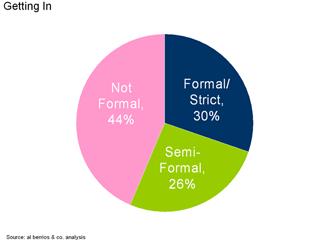 |
If you're fortunate enough to know a professional networker, you've probably solicited advice on how to network. The advice is, naturally, forthcoming, because "the more, the merrier", but rarely is this advice based on any formal analysis. Networking, as you've undoubtedly been told, is about initiative (what you make of it), bridging (facilitating introductions), and giving and gaining (with an emphasis on giving, even though all we ever really want is gain). Networkers believe in it so blindly, that they often offer their facilities as meeting venues, free of charge, without guarantees (measurable or otherwise) of value. In a new analysis of 23 general professional business networking groups with presence in New York City, we attempt to qualify an earlier argument behind the economics of networking (1) with data. What we've found is that networking is a ritual performed inefficiently, no group operating reasonably optimally, nor completely valueless.
Getting In
As with any experience, the first one counts the most. Whether or not a guest is aware of it, they want to experience an orderly way of doing things, a compelling reason to join. A majority of the groups we reviewed claim to have an orderly way of processing new members, however, in practice, just 30% have a formal/strict procedure. Imagine if just 30% of the rides at Disney's theme parks were working while you were there, or worse, if just 30% of their "cast members" were in-character while you're with your kids? Would you pay them to return, ever? Despite this, 65% of our groups charge for joining (and they want their money promptly). Dues are believed to create commitment, but in our economic argument we debated this logic as dubious.
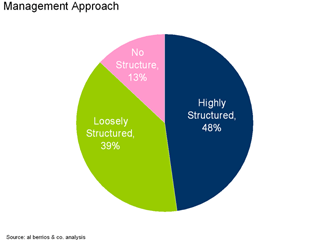 |
Getting Business
Why would anyone commit to a group that leaves a first impression much to be desired? The argument used by leaders is that it reserves a professional category for the member, meaning that no other person who does the same thing would even be considered. With a virtual monopoly, it's thought that all opportunities needing what you do will naturally go to you. In our economic argument, we also debated this as an irrational argument merely because it creates the potential for stagnancy. What monopoly cares about quality? Our analysis reveals that despite the seemingly overwhelming number of groups that close off competition to dues-paying members, they are in the minority, with just 39% of them being closed vs. 61% of networking groups being open, welcoming everyone (2).
Getting Value
Not surprisingly, the fact that networkers even get together (without additional compensation) requires even the most basic level of organization. Thus said, just a sliver, 13% of networking groups, have no formal management structure, where "members" willy-nilly about without purpose or goals. (This shouldn't imply that structure guarantees value: approximately 4% track what becomes of leads given and business done, with the rest relying on anecdotal evidence to evaluate the success of their groups. To these groups, tracking is anathema, a rankling mentality to say the least). Interestingly, most of that industriousness gets expended emphasizing the social aspect of getting together under the premise that friendlier relationships increase the likelihood of getting more value from networking. (Networking is therefore almost 70% business - or boring, depending on how you look at it. Those seeking intellectual stimulation need not bother networking. Go to graduate school instead).
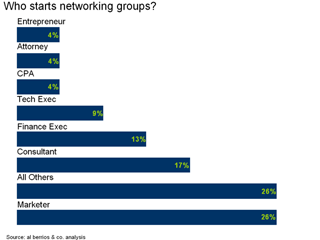 |
Our sample group reaches an (offline) aggregate network of over 342,000 professionals, the majority being experienced entrepreneurs (or salesmen) and senior corporate executives. Regrettably, one can't meet them all. So groups have gone online to connect, with 78% having some sort of online presence and 74% having active email forums. You will often find that candidates will want to join just for access to these online resources, but disappointingly, just 9% of our sample separate their membership in such a way to let candidates choose to just participate via email, with the majority making attendance to periodic meetings a requirement for membership.
Extra
So, who starts networking groups? Not surprisingly, marketers, followed by consultants (of all colors), then folks in some sort of finance-related profession.
Methodology + Definitions
I didn't get the idea for an analysis of groups until after I had sent out my 6th or 7th email to colleagues asking about networking opportunities I had been involved with. I sent a similar email reviewing about 10 groups, and everyone liked it. I realized that my analysis was objective enough, covering enough groups, that it warranted a formal analysis. To that end, I tallied every group I had ever visited - nearly 50 - counting different chapters of the same group only once, and excluding special interest groups (i.e. Latino and faith-based). I define a professional networking group as a group of 4 or more individuals in any profession that come together regularly and on a schedule, online or off, without compensation for any purpose. The degrees on which I rated their application process, operating structure, and management approach were based on my own perspectives on organizational behavior. I evaluated operating formats and membership composition based on my direct post-visit follow-up with hundreds of members, as well as my own rating of industry trade events I've personally attended.
Write to Al Berrios
at editor@alberrios.com
Top
Footnotes
(1) "The Economic Theory of the Professional
Networking Group"
(2) Explanation of Open
and Closed Groups: Open groups are defined as those that welcome multiple representatives
in each business category, whether that category is defined as industry or service.
Closed groups are defined as those that limit industry and service categories
to one representative.
Top
More
Data
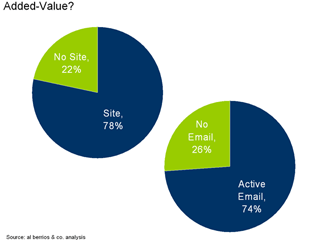 |
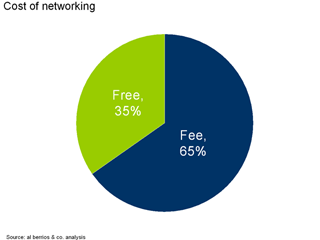 |
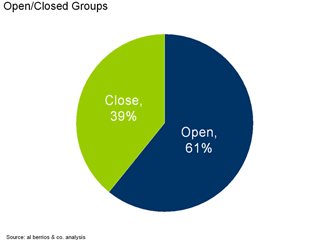 |
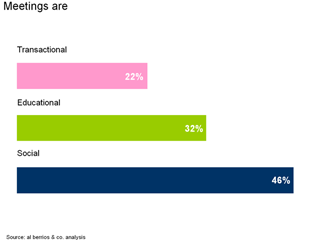 |
Disclaimer:
The recommendations, commentary and opinions published herein are based on
public information sometimes referenced via hyperlinks. Any similarities or
likeness to any ideas or commentary from any other sources not referenced
is purely coincidental. al berrios & co. cannot control any results occurring
from advice obtained from this publication nor any opinion(s) conveyed by
any reader of this publication.
(c) 2005. All Rights Reserved. al berrios & company, inc. Published
by al berrios & co. This Report may not be reproduced or redistributed
in any form without written permission from al berrios & co., subject
to penalty.